After unifying the Mongols, Genghis Khan led his army from Northern Mongolia in 1211 to the Caspian Sea in 1224, forging the largest contiguous land empire in history. For centuries, common wisdom held that the Mongols were driven to conquest because of harsh conditions – namely, drought. Our new record, dating back to 900AD with confidence, indicates the opposite.
Published in PNAS, our new tree-ring data suggests that it was consistently wet from 1211 to 1225CE, a period we are calling the Mongol Pluvial. No years during this period were below the long-term average, which is the only run of moisture conditions in our 1,100-year-long record. Independent tree-ring records of the same area also indicate that this period was warm.
Grass is life
On the cool semi-arid steppe of Central Asia, water is life and, in those days, water was energy. The Mongol diet is heavily based on the meat of grazing animals. Their mode of transportation was the short, but Pheidippidic, horse. So, for food and for travel, grass was life. Grass was energy.
An abundance of moisture would seem to provide the horsepower for the rapidly growing Mongol Empire. The Mongol soldier typically had five steeds at their disposal. With a large army, that quickly translates into huge herds and a huge need for grass.
The tree-ring records we collected suggest that the grasslands of central Mongolia were probably productive during this period of unprecedented moisture and mild temperatures. The tree-ring data strongly agrees with satellite estimates of grassland productivity during the modern period. Going back in time, then, the trees would suggest that during its rapid expansionm the Mongol Empire was sitting in a sea of grass – a sea of energy – a potential abundance of life.
Branch biopsies
As with many scientific discoveries, our initial finding that Siberian pine trees from the Khorgo lava field in Central Mongolia yielded data that matched the year that Genghis Khan was born, was initially an accidental one. We had collected samples as an aside to another project we were doing (Fire, Climate, and Forest History in Mongolia). When they were finally analysed, it was with great surprise that we learnt of the correlation they showed with Genghis Khan’s empire-building. We had to go back for more samples.
Using tree rings from these, we reconstructed a 1,112-year water-balance record. Trees are sedentary creatures, sitting in one spot for centuries unable to move from fire, drought or other ravages of time. Thus, they have to sit there and take what is thrown at them.

For tree-ring scientists like ourselves, changes in the environment are recorded in the structure of the trees – clues about their age – and in the rings of their branches. We seek out the oldest looking trees on the landscape and take small samples, like a biopsy, that are the diameter of a chopstick. And, on dry sites like the Khorgo lava field, we took samples from dead trees to extend the living tree record further back in time by matching the unique patterns of large and small rings.
The rings in one sense can be considered a bar code of information. The information we glean from the bar code made of wood indicates the growth of these trees are severely limited by moisture. We test this hypothesis statistically by comparing ring width measurements and human measures of moisture availability. So, when we see 15 years of above average ring widths in the early 1200s, this indicates wet conditions.
That is our hypothesis, at least, and something we will test in the coming years with historical documents, environmental records from lake sediments, more tree rings, and ecological modelling experiments.
Cultural transformation
While this record speaks to a rapid transformation of Eurasian culture during the 13th century, it also speaks about an abrupt transformation in Mongol culture today. Towards the end of our tree-ring record we see a prolonged drought from the end of the 20th century into the beginning of the 21st century. This drought followed the wettest century of the last 11 and occurred during the warmest period of the last 1,100 years in Asia.
The abrupt transition in environmental conditions – one that’s seen hundreds of lakes and wetlands disappear from the region’s landscape – occurred during the move from a more agriculturally based economy to a more urban one. These severe conditions, in combination with some harsh winters, killed millions of livestock and are thought to be one trigger of a mass migration of Mongols from the countryside into the capital of Ulaanbaatar.
Though we don’t have the data to connect this heat drought to climate change, warming temperatures have stacked the deck towards causing higher amounts of evaporation, so even if the amount of precipitation remains the same, high temperatures will generate a more intense drought. That’s what we observed in the early 21st century and based on past moisture variation in Mongolia and future predictions of warming, we would expect to see similar events in the future.

